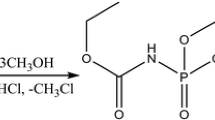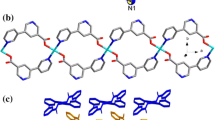Abstract
Co(II), Ni(II), Cu(II) and Cd(II) chelates with 1-aminoethylidenediphosphonic acid (AEDP, H4L1), α-amino benzylidene diphosphonic acid (ABDP, H4L2), 1-amino-2-carboxyethane-1,1-diphosphonic acid (ACEDP, H5L3), 1,3-diaminopropane-1,1,3,3-tetraphosphonicacid (DAPTP, H8L4), ethylenediamine-N,N′-bis(dimethylmethylene phosphonic)acid (EDBDMPO, H4L5), O-phenylenediamine-N,N′-bis(dimethyl methylene phosphonic)acid (PDBDMPO, H4L6), diethylene triamine-N,N,N′,N′,N″N″-penta(methylene phosphonic)acid (DETAPMPO, H10L7) and diethylene triamine-N,N″-bis(dimethyl methylene phosphonic)acid (DETBDMPO, H4L8) have been synthesised and were characterised by elemental and thermal analyses as well as by IR, UV–VIS, EPR and magnetic measurements. The first stage in the thermal decomposition process of these complexes shows the presence of water of hydration, the second denotes the removal of the coordinated water molecules. After the loss of water molecules, the organic part starts decomposing. The final decomposition product has been found to be the respective MO·P2O5. The data of the investigated complexes suggest octahedral geometry with respect to Co(II) and Ni(II) and tetragonally distorted octahedral geometry with respect to Cu(II). Antiferromagnetism has been inferred from magnetic moment data. Infrared spectral studies have been carried out to determine coordination sites.











Similar content being viewed by others
References
Delvin BRJ. Shell International Research Maats Chappis B.V. Brit. 11; 1978. p. 508, 772 (c, AO1N 9136).
Delvin BRJ Shell International Research Maats Chappis B.V. Brit. 74115; 1974. p. 15, 255.
Delvin BRJ Chem Abstr 1974;90:34989e.
Schindler N, Ploeger W, Ger Offen 1972;2048:913–18 (2,048,913 Appl P).
Schindler N, Ploeger W, Ger Offen. Chem Abstr;77:19799d.
Kabachnik MI, Medved TYa, Arkhipova OG, Dyatlova NM, Rudomino MV. Organophosphorus complexones. Russ Chem Rev. 1968;7:503–18.
Zablotna R, Zylicz E, Szot Z, Peskorska C, Anna G. Nukleonika 1977;22(8):703–11 (in English).
Zablotna R, Zylicz E, Szot Z, Peskorska C, Anna G (1978) Chem Abstr 88:59775h.
Balabukha VS, IrannikovAI, Razhitnaya LI, Razamovskii NC, Tikhonaya LI, Baranovskaya LM. In: Second European Congress on Radiation Protection, 1972; 1973 pp. 293–298 (in English).
Balabukha VS, IrannikovAI, Razhitnaya LI, Razamovskii NC, Tikhonaya LI, Baranovskaya LM. Chem Abstr 1974;80:45278q.
Ploger W, Schindler N, Wollmann K, Woras KN. Herstellung von 1-Aminoalkan-1,1-diphosphonsäuren. Z Anorg Allg Chem. 1972;389:119.
Lerch I, Kottler A German Patent no 1,002,355, Feb 14; 1957.
Lerch I, Kottler A. Chem Abstr 1959;53:21814c.
Kabachnik MI, Medved TYa, Kozlova GK, BalaBukhaVS, Senyavin MM, Tikhonova LI. Izv Akad Nauk SSSR Ctd Khim Nauk 1958;1070.
Kabachnik MI, Medved TYa, Kozlova GK, BalaBukhaVS, Mironova EA, Tikhonova. LI Izv Akad Nauk SSSR Ctd Khim Nauk 1959;53:3039h.
Kabachnik MI, Medved TYa, Kozlova GK, BalaBukhaVS, Mironova EA, Tikhonova LI. Izv Akad Nauk SSSR Ctd Khim Nauk 1958;1070.
Kabachnik MI, Medved TYa, Kozlova GK, BalaBukha VS, Mironova EA, Tikhonova LI. Izv Akad Nauk SSSR Ctd Khim Nauk 1960;651.
Kabachnik MI, Medved TYa, Kozlova GK, BalaBukhaVS, Mironova EA, Tikhonova LI. Izv Akad Nauk SSSR Ctd Khim Nauk 1967;1501.
Kabachnik MI, Medved TYa, Kozlova GK, BalaBukhaVS, Mironova EA, Tikhonova LI. Izv Akad Nauk SSSR Ctd Khim Nauk Chem Abstr 1959;53:3039f.
Kabachnik MI, Medved TYa, Kozlova GK, BalaBukhaVS, Mironova EA, Tikhonova LI. Izv Akad Nauk SSSR Ctd Khim Nauk Chem Abstr 1960;54:22329b.
Kabachnik MI, Medved TYa, Kozlova GK, BalaBukhaVS, Mironova EA, Tikhonova LI Izv Akad Nauk SSSR Ctd Khim Nauk Chem Abstr 1968;68:24798w.
Peck DR, Hudson D. Brit. 1,42,294 (Cl C07f).
Peck DR, Hudson D. Chem Abstr 1969;70:106650x.
Medved TYa, Rudomino MV, Mironova EA, BalaBukha VS, Kabachnik MI. Izv Akad Nauk Ser Khim. 1967;2:351–6. (Russian).
Rao BV. Ph.D thesis. Kurukshetra University, Kurukshetra; 1985.
Vogel AI. A text book of quantitative inorganic analysis. 7th ed. London: Longman; 1996.
Venkateswara Rao B, Puri DM. Iron(II) and iron(III) complexes of organophosphonic acids. Orient J Chem. 2009;25(1):85.
Palta N, Rao BV, Dubey SN, Puri DM. Organophosphonic acids as complexones. Part IV. Polymeric complexes of ethylenediamine-N,N′-bis(methylenephosphonic acid and phenylenediamine-N,N′-bis(methylenephosphonic acid). Indian J Chem. 1984;23A:397.
Palta N, Rao BV, Dubey SN, Puri DM. Ethylenediamine-N′,N′,N″,N″-tetrakis(methylenephosphonic)acid as complexing agent. Polyhedron. 1984;5:527.
Żurowska B, Mrozinski J, Ochocki J. Coordination properties of the diethyl 2-quinolilmethylphosphonate ligand with chloride and nitrate transition-metal salts. Mater Sci. 2007;25(4):1063–74.
Saad EA, Ramadan RM. Synthesis and characterization of some new organophosphonates and their adducts with some metal salts. Bull Chem Soc Jpn. 1989;62:3697–700.
Tusek-Bozic L, D’alpaos M, Curic M, Lycka A. Synthesis and Characterization of metallocyclic complexes of palladium(II) with monoalkyl (alpha-anilino-N-benzyl)phosphonates. Croat Chem Acta CCACAA. 2001;74(4):825–36.
Nash KL, Rogers RD, Ferraro J, Zhang J. Lanthanide complexes with 1-hydroxyethane-1,1-diphosphonic acid: solvent organization and coordination geometry in crystalline and amorphous solids. Inorgan Chim Acta 1998;269(2):211.
Ochocki J, Zurowska B, Mrozinski J, Kooijman H, Spek AL, Reedijk J. Synthesis, spectroscopy, and magnetic properties of transition-metal complexes with the diethyl 2-quinolylmethylphosphonate (2-qmpe) ligand—crystal structures of [Ni(2-qmpe)4(H2O)2](ClO4)2 and [Mn(2-qmpe)4(H2O)2] (ClO4)2 showing unexpected O-binding of the qmpe ligands. Eur J Inorg Chem. 1998;2:169.
Scheinmann F, editor. An introduction to spectroscopy methods for the identification of organic compounds. Oxford: Pergamon Press; 1970.
Fujita J, Nakamoto K, Kobayashi M. Infrared spectra of metallic complexes II. The absorption bands of coördinated water in aquo complexes. J Am Chem Soc. 1956;78:3963.
Jani GR, Vyas KB, Franco Z. Preparation and antimicrobial activity of s-triazine hydrazones of 7-hydroxy coumarin and their metal complexes. E-Journal Chem. 2009;6(4):1228.
Reddy V, Patil N, Angadi SD. Synthesis, characterization and antimicrobial activity of Cu(II), Co(II) and Ni(II) complexes with O, N, and S donor ligands. E-J Chem. 2008;5(3):577–83.
Sengupta SK, Sahni SK, Kapoor RN. Mixed ligand complexes of ruthenium(III), rhodium(III), iridium(III) with dipicolinic acid and some mono basic bidentate nitrogen, oxygen donor ligands. Polyhedron. 1983;2:317.
Maurya RC, Chourasia J, Sharma P. Synthesis, characterization and 3D molecular modeling of some ternary complexes of Cu(II), Ni(II), Co(II), Zn(II), Sm(III), Th(IV) and UO2(VI) with Schiff base derived from the sulfa drug sulfabenzamide and 1,10-phenanthroline. Indian J Chem. 2007;46A:1594–604.
Maurya RC, Sharma P, Sutra Dhar D. Synthesis, magnetic, and spectral studies of some mixed-ligand complexes of copper(II) involving diphenic acid and pyridine or aniline derivatives. Synth React Inorg Met Org Chem. 2003;33:669.
Kose DA, Gokce G, Gokce S, Uzun I. Bis(N,N-diethylnicotin-amide) p-chlorobenzoate complexes of Ni(II), Zn(II) and Cd(II). J Therm Anal Calorim. 2009;95:247–51.
Dyer JR. Applications of absorption spectroscopy of organic compounds. New Delhi: Prentice Hall of India; 1978. p. 37.
Sharma R, Bansal KA, Nagar M. Transition metal complexes of cis-3,7-dimethyl-2,6-octadien-thiosemicarbazone: synthesis, characterization and biocidal studies. Indian J Chem. 2005;44A:2255.
Souanya ER, Ismail EH, Mohamed AA, Milad NE. Preparation, characterization and thermal studies of some transition metal ternary complexes. J Therm Anal Calorim. 2009;95(1):253–8.
Syamal A, Maurya MR. Coordination chemistry of schiff base complexes of molybdenum. Coord Chem Rev. 1985;95:183.
Maurya RC, Mishra DD, Mukherjee S, Trivedi PK. Synthesis, magnetic and spectral studies of mixed-ligand derivatives of cobalt(II) and nickel(II)-β-diketonate and β-diketoesters with some potentially bi- and tri-dentate heterocyclic nitrogen donors. Synth React Inorg Met Org Chem. 1991;21:1107.
Lever ABP. Inorganic electronic spectroscopy. 2nd ed. New York: Elsevier; 1986.
Rogan J, Poleti D, Karanovic L, Bogdanovic G, Spasojevic-de Bire A, Petrovic DM. Mixed ligand Co(II), Ni(II) and Cu(II) complexes containing terephthalato ligands. Crystal structures of diaqua(2,2′-dipyridylamine) (terephthalato)metal(II)trihydrates (metal = cobalt or nickel). Polyhedron. 2000;19:1415.
Sharma HK, Chandra S, Gupta S. Synthesis and spectral studies of nickel(II) and cobalt(II) complexes of a twelve-membered and tetradentate macrocyclic ligand. Synth React Inorg Met Org Chem. 1997;27(8):1083.
Sivasankar B. Cobalt(II), nickel(II) and zinc(II) dicarboxylate complexes with hydrazine as bridged ligand: characterization and thermal degradation. J Therm Anal Calorim. 2006;86(2):385–92.
Vikram L, Shanthakumar D, Ragul R, Sivasankar B. Spectral and thermal studies on new hydrazinium metal sulfite dehydrates. J Therm Anal Calorim. 2007;89(2):521–4.
Yeşilel OZ, Ölmez H. Spectrothermal studies of 1,10-phenanthroline complexes of Co(II), NI(II), Cu(II) and Cd(II) orotates. J Therm Anal Calorim. 2006;86(1):211–6.
Yeşilel O, Ölmez H. Syntheses and spectrothermal studies of triethanolamine complexes of Co(II), Ni(II), Cu(II) and Cd(II) squarates. J Therm Anal Calorim. 2007;89(1):261–5.
Modi CK, Patel SH, Patel MN. Transition metal complexes with uninegative bidentate Schiff base: synthetic, thermal, spectroscopic and coordination. J Therm Anal Calorim. 2007;87(2):441–8.
Kose DA, Gokce G, Gokce S, Uzun I. Bis(N,N-diethylnicotinamide)p-chlorobenzoate complexes of Ni(II), Zn(II) and Cd(II) synthesis and characterization. J Therm Anal Calorim. 2009;95:247.
Cotton FA, Wilkinson G, Murillo CA, Bochmann M. Advanced inorganic chemistry. 6th ed. New York: Wiley; 1999.
Maurya RC, Sharma P, Roy S. Synthesis and characterization of some mixed-ligand picrate complexes of nickel(II) involving heterocyclic nitrogen donors. Synth React Inorg Met Org Chem. 2003;33:683.
Ferenc W, Bocian B, Sarzyński J. Thermal, spectral and magnetic behaviour of 2,3,4-trimethoxybenzoates of Mn(II), Co(II), Ni(II) and Cu(II). J Therm Anal Calorim. 2006;84(2):377–83.
Ferenc W, Cristóvão B, Sarzyński J. Complexes of Mn(II), Co(II), Ni(II), Cu(II) and Zn(II) with 4-chloro-2-methoxybenzoic acid anion. J Therm Anal Calorim. 2006;86(3):783–9.
Dianzhong F, Bo W. Complexes of cobalt(II), nickel(II), copper(II), zinc(II) and manganese(II) with tridentate Schiff base ligand. Trans Met Chem. 1993;18:101.
Dutta RL, Syamal A. Elements of magnetochemistry. 2nd ed. New Delhi: Affiliated East-West Press Pvt. Ltd.; 1993. p. 57, 107.
Dubey RK, Mishra CM. Synthesis, reactions, spectral and magnetic studies of chloro-[2-o-hydroxyphenyl)]-benzimidazolato]-cobalt(II). Indian J Chem. 2006;45A:2203–8.
Aggarwal RC, Bala R, Prasad RL. Ternary complexes of oxovanadium(IV), manganese(II), cobalt(II), nickel(II), copper(II) and zinc(II) with 2-aminobenzoic acid and 1-nitroso-2-naphthol. Indian J Chem. 1983;22A:955.
El-Dissouky Ali, Mohamed GR, Refaat LS. Metal chelates of heterocyclic nitrogen containing ketones, XIII. Cobalt(II), nickel(II) and palladium(II) complexes of 2-picolyl- and 2-lutidyl-methyl ketones. Trans Met Chem. 1984;9:23.
Andrew JE, Ball PW, Blake VB. Binuclear cobalt(II) and nickel(II) complexes of dihydrazinophthalazine and dipyridylpyridazine: the dependence of superexchange on electronic configuration. Chem Commun 1969;143.
Ball PW, Blake AB. Magnetic properties of polynuclear complexes. Part I. Superexchange in some binuclear nickel(II) complexes. J Chem Soc 1969;1415–22.
Bhatnagar SS, Khanna ML, Nevgi MB. Phil Mag 1938;25.
Figgis BN, Lewis J. In: Cotton FA, editors. Progress Inorgan Chem. New York: Wiley-lnterscience; 1964. p. 188.
Palta N. Ph.D thesis. Kurukshetra University, Kurukshetra; 1964.
Figgis BN. Introduction to ligand fields. New Delhi: Wiley Eastern; 1966.
Manhas BS, Kalia SB, Sardana AK, Kaushal G. Magnetic and spectroscopic characterization of copper(II) chlorobenzoate adducts with substituted piperidines. Indian J Chem. 2005;44A:1576–81.
Low W Paramagnetic resonance in solids. Suppl 2. In: Seity F, Turnbull D, editors. Solid State Phys. New York: Academic Press; 1960. p. 92.
Abraham A, Bleaney B. Electron paramagnetic resonance of transition metal ions. Oxford: Clarendon Press; 1970.
Acknowledgements
Thanks are due to C.S.I.R fellowships to Dr. B.V.R. Thanks are also due to Management of ALC for encouragement.
Author information
Authors and Affiliations
Corresponding author
Rights and permissions
About this article
Cite this article
Rao, B.V. Studies of Co(II), Ni(II), Cu(II) and Cd(II) chelates with different phosphonic acids. J Therm Anal Calorim 100, 577–587 (2010). https://doi.org/10.1007/s10973-009-0512-7
Received:
Accepted:
Published:
Issue Date:
DOI: https://doi.org/10.1007/s10973-009-0512-7




